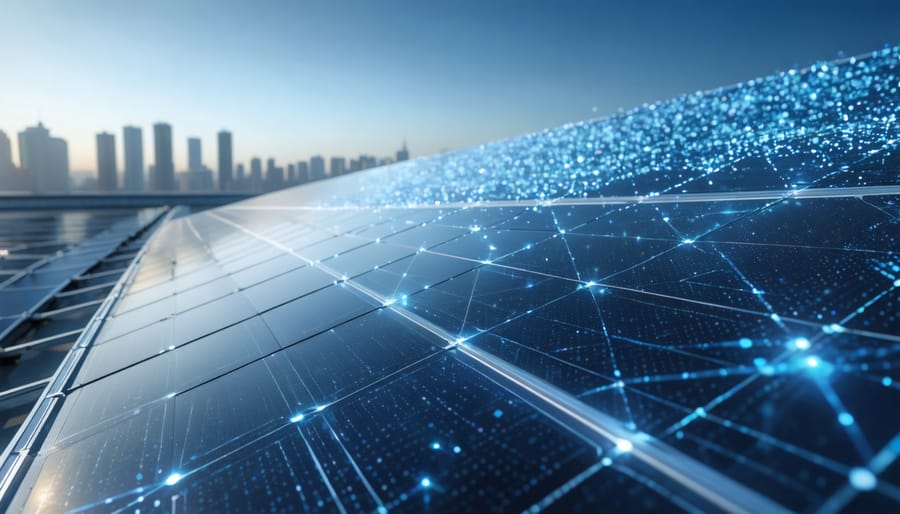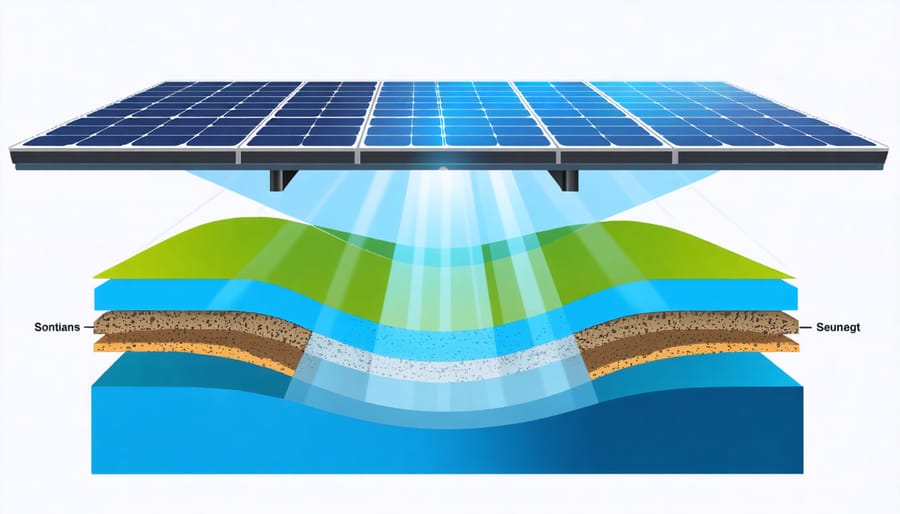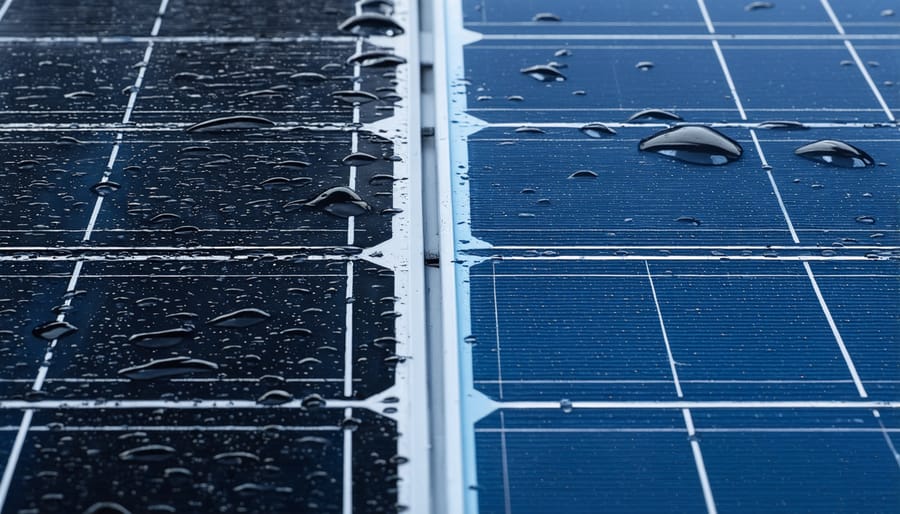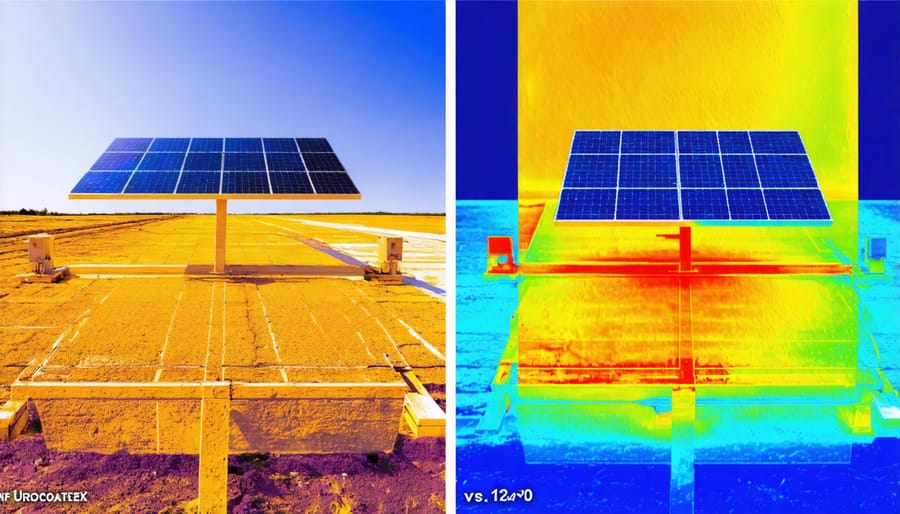These Breakthrough Solar Panel Coatings Boost Energy Output by 25%

Revolutionary advances in solar panel technology are reshaping Europe’s renewable energy landscape, delivering unprecedented efficiency gains and cost reductions. Modern solar panels now achieve conversion rates above 25%, thanks to breakthrough innovations in photovoltaic coatings and smart material engineering. These technological leaps have transformed solar energy from an alternative power source into a mainstream solution for sustainable energy generation.
The integration of artificial intelligence and IoT sensors into solar panel systems has enabled real-time performance optimization and predictive maintenance, maximizing energy yield while minimizing operational costs. Cutting-edge anti-reflective coatings, perovskite-silicon tandems, and bifacial cell designs are pushing the boundaries of what’s possible in solar energy capture, offering European businesses and homeowners increasingly compelling reasons to invest in solar technology.
From self-cleaning surfaces that maintain peak performance in challenging environments to advanced thermal management systems that preserve efficiency during heat waves, today’s solar panels represent a convergence of multiple technological innovations. These developments are particularly significant for European markets, where varying climate conditions and strict energy efficiency standards demand sophisticated solar solutions that can deliver reliable performance year-round.
Anti-Reflective Nanotechnology: The Game-Changer in Solar Efficiency
How Nano-Coatings Capture More Sunlight
Recent advancements in nano-materials in solar efficiency have revolutionized how solar panels capture and utilize sunlight. These innovative nano-coatings work by creating an ultra-thin layer on the surface of solar cells, typically measuring just a few nanometres in thickness.
The nano-coating technology employs a sophisticated light-trapping mechanism that significantly reduces reflection and increases light absorption. When sunlight hits a conventional solar panel, some of it bounces off the surface, resulting in lost energy potential. Nano-coatings create a gradual transition in the refractive index between air and the solar cell, effectively minimizing this reflection.
These coatings feature specially designed nanostructures that scatter incoming light at various angles within the solar cell, increasing the optical path length of photons. This means that light spends more time within the solar cell, dramatically improving the chances of photon absorption and subsequent electricity generation.
European research institutes have developed advanced nano-coating formulations that are particularly effective in northern European climate conditions, where diffuse light is common. These coatings can enhance energy capture even during overcast days, making solar installations more viable across diverse geographical locations.
The durability of modern nano-coatings has also improved significantly, with many manufacturers now offering solutions that maintain their effectiveness for 20+ years while requiring minimal maintenance.

Real-World Performance Improvements
Recent data from European solar installations demonstrates remarkable improvements in real-world performance through advanced technology integration. In Germany, a large-scale commercial installation in Bavaria reported a 23% increase in energy yield after implementing the latest generation of anti-reflective coatings. This improvement translated to an additional 127 MWh of annual energy production from the 2-hectare facility.
Similar success stories emerge from Spain, where a municipal solar farm in Valencia achieved a 19% efficiency gain through a combination of self-cleaning nano-coatings and enhanced light-capturing technology. The installation now powers 15% more households than initially projected, serving an additional 320 families in the region.
In the Netherlands, a pioneering project incorporating bifacial panels with advanced surface treatments showed particularly impressive results during overcast conditions. The installation maintained 85% of its rated efficiency even during typical cloudy weather, compared to the previous generation’s 65% performance under similar conditions.
Swedish researchers documented a notable case study where industrial rooftop installations using the latest panel technology maintained peak performance for 18% longer during winter months. This breakthrough particularly benefits northern European installations, where shorter daylight hours traditionally limited solar energy potential.
These real-world examples demonstrate how technological innovations are making solar energy increasingly viable across diverse European climates and conditions, delivering tangible benefits to both commercial and residential installations.
Self-Cleaning Surfaces: Maintaining Peak Performance
Hydrophobic Coating Technology
Modern solar panels benefit significantly from self-cleaning hydrophobic coatings, which represent a breakthrough in maintenance efficiency and performance optimization. These innovative coatings create an ultra-smooth, water-repelling surface that prevents water droplets from adhering to the panel’s surface. Instead, the droplets roll off, carrying dust, dirt, and other debris with them.
This technology mimics the natural self-cleaning properties found in lotus leaves, known as the “lotus effect.” When rain falls on treated panels, it forms nearly perfect spherical droplets that maintain minimal contact with the surface, effectively cleaning the panels as they roll off. This natural cleaning mechanism can reduce maintenance requirements by up to 90% while ensuring consistent energy production.
The coating’s effectiveness is particularly valuable in European regions with varying weather conditions. In areas with high pollution levels or frequent dust storms, these coatings maintain panel efficiency without requiring regular manual cleaning. During winter months, the hydrophobic properties also help prevent snow accumulation and ice formation, which can significantly impact energy generation.
The durability of modern hydrophobic coatings typically extends beyond 10 years, making them a cost-effective solution for both residential and commercial installations. This innovation not only enhances panel performance but also contributes to reduced maintenance costs and extended system longevity.

Photocatalytic Self-Cleaning Process
The photocatalytic self-cleaning process in solar panels relies on an innovative titanium dioxide (TiO2) coating that actively breaks down organic matter when exposed to sunlight. This advanced technology creates a powerful chemical reaction that effectively eliminates dirt, bird droppings, and other organic materials that typically accumulate on panel surfaces.
When UV rays hit the specially treated surface, they activate the TiO2 coating, generating reactive oxygen species (ROS) and hydroxyl radicals. These highly reactive molecules attack organic compounds, breaking them down into harmless substances like water and carbon dioxide. This process, known as photocatalytic oxidation, continues throughout daylight hours, providing constant cleaning action.
The efficiency of this self-cleaning mechanism is enhanced by the coating’s superhydrophilic properties, which create an ultra-thin water layer across the panel surface when it rains. This water layer helps wash away the decomposed organic matter, leaving the surface clean and maintaining optimal energy generation capacity.
European testing has demonstrated that panels equipped with photocatalytic coatings maintain up to 98% of their original efficiency even after extended exposure to environmental conditions. This significant improvement in maintenance requirements has made these coatings increasingly popular among solar installation projects across Europe, particularly in regions with high pollution levels or frequent bird activity.
Temperature-Regulating Coatings

Heat Management Innovation
Heat management plays a crucial role in maximising solar panel efficiency, and innovative coating technologies are revolutionising how we address temperature-related challenges. When solar panels become too hot, their efficiency can drop by 0.5% for each degree above optimal operating temperature, significantly impacting energy production.
Modern thermal management coatings work through several sophisticated mechanisms. These include selective absorption layers that capture useful solar radiation while reflecting excess heat, and thermally conductive materials that efficiently dissipate heat away from critical components. Some advanced coatings even incorporate phase-change materials that absorb excess heat during peak temperatures and release it when panels cool down.
European research institutes have developed smart coating solutions that automatically adjust their thermal properties based on temperature changes. These adaptive materials can maintain optimal operating conditions across diverse climate zones, from Mediterranean summers to Nordic winters. For instance, installations in southern Spain have shown up to 15% improvement in energy yield during hot summer months using these temperature-regulating coatings.
The latest generation of heat management solutions also features self-cleaning properties, preventing dust accumulation that can trap heat and reduce efficiency. This dual-action approach ensures consistent performance while minimising maintenance requirements.
Performance in Extreme European Climates
Modern solar panel coatings face unique challenges across Europe’s diverse climate zones, from the intense Mediterranean sun to the harsh Nordic winters. Recent studies show that advanced hydrophobic and anti-reflective coatings significantly improve weather performance impacts in extreme conditions. In Northern Europe, self-cleaning coatings help panels maintain efficiency despite frequent rainfall and snow, reducing maintenance needs by up to 40%.
Southern European installations benefit from thermal-regulating coatings that prevent efficiency losses during intense heat waves, maintaining optimal performance even when temperatures exceed 40°C. These innovations have shown particular effectiveness in coastal areas, where salt spray resistance has improved panel longevity by 25%.
Testing in Alpine regions demonstrates that modern coating technologies can withstand severe temperature fluctuations, heavy snow loads, and high UV exposure. Anti-icing coatings have reduced snow accumulation by 60%, ensuring consistent energy production throughout winter months. Moreover, these protective layers have proven particularly effective in industrial areas, where air pollution and particulate matter traditionally impact panel efficiency, maintaining up to 95% of initial performance levels over extended periods.
Implementation and Investment Benefits
Installation Process and Requirements
The installation of advanced solar panel coatings requires careful preparation and precise execution to ensure optimal performance. The process typically begins with a thorough cleaning of the panel surface using specialised solutions that remove dirt, dust, and other contaminants without damaging the existing components.
Before application, technicians conduct a detailed inspection to identify any surface irregularities or damage that might affect coating adhesion. The ambient temperature and humidity must fall within specific parameters, typically between 10-30°C with relative humidity below 85%, to ensure proper curing.
The coating application itself follows a systematic approach:
1. Application of primer layer (where required)
2. Even distribution of the main coating using automated spray systems or roller applications
3. Quality control inspection during application
4. Controlled curing period under specific environmental conditions
For most modern coating systems, the entire process takes 24-48 hours, including curing time. Professional installation teams use advanced monitoring equipment to ensure uniform coverage and optimal thickness throughout the application.
Essential requirements include:
– Clean, controlled environment
– Professional-grade application equipment
– Certified installation technicians
– Proper personal protective equipment
– Quality control documentation
– Weather monitoring systems
Post-installation inspection involves various tests to verify coating uniformity, adhesion strength, and thickness consistency. Regular maintenance checks are scheduled to monitor coating performance and identify any areas requiring attention, ensuring long-term effectiveness of the solar panel system.
Cost-Benefit Analysis
Investing in advanced solar panel technology requires careful financial consideration, balancing initial costs against long-term benefits. Recent solar panel efficiency improvements have significantly enhanced the return on investment potential for both residential and commercial installations.
The initial investment for premium solar panels with advanced technology typically ranges from €6,000 to €15,000 for residential systems and €50,000 to €200,000 for commercial installations. However, these systems offer compelling financial advantages:
Energy Cost Reduction: Modern solar installations can reduce electricity bills by 50-90%, depending on system size and local conditions. Most European households recover their investment within 5-8 years through energy savings alone.
Government Incentives: Many European countries offer substantial subsidies, tax breaks, and feed-in tariffs. For example, Germany’s renewable energy incentives can cover up to 25% of installation costs, while France offers tax credits of up to 30%.
Property Value Enhancement: Solar installations typically increase property values by 3-4%, offering additional return on investment beyond energy savings.
Maintenance Costs: Advanced coating technologies extend panel lifespan to 25-30 years, with minimal maintenance requirements averaging €150-200 annually.
Carbon Credit Benefits: Commercial installations may qualify for carbon credit trading, providing additional revenue streams in participating European markets.
When factoring in rising energy costs and technological improvements, most installations achieve complete return on investment within 6-10 years, followed by decades of pure savings.
The remarkable advancements in solar panel coating technologies represent a significant leap forward in renewable energy efficiency and sustainability. These innovations have transformed the way we harness solar power, offering enhanced performance even in challenging weather conditions and extending the lifespan of solar installations across Europe.
From self-cleaning hydrophobic coatings that minimize maintenance requirements to anti-reflective solutions that boost energy capture by up to 3%, these technological developments are making solar energy more accessible and economically viable for both homeowners and businesses. The integration of smart coating materials has particularly revolutionized solar panel efficiency in regions with variable climate conditions, a crucial factor for European implementations.
Looking ahead, the future of solar panel coatings appears increasingly promising. Research institutions and manufacturers across Europe continue to develop next-generation solutions, including temperature-regulating coatings and advanced nanomaterials that could push efficiency boundaries even further. These innovations are expected to reduce installation costs while improving long-term performance, making solar energy an even more attractive investment.
As sustainability becomes increasingly central to European energy policy, the role of coating technologies in maximizing solar panel effectiveness will become even more crucial. With continued investment in research and development, we can expect to see even more sophisticated coating solutions emerging, supporting Europe’s transition to renewable energy and contributing to a more sustainable future for generations to come.
Leave a Reply